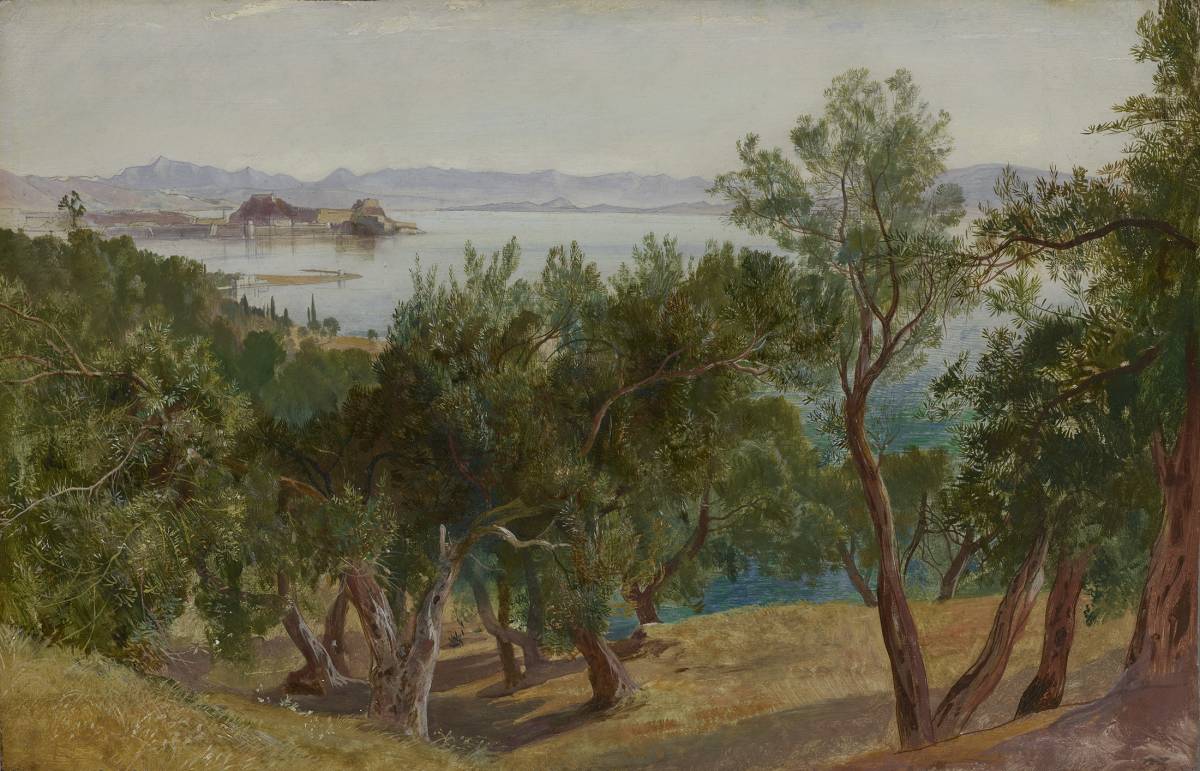‘Over head ever the loved olive: far below ‘bowery hollows’ of green – ever & ever retreating: spotless blue above; glimpses of darker blue sea, & pearly radiant mountain through the transparent foliage.’[1]
This exceptionally beautiful, plein air painting was made by Edward Lear during his residence on the Island of Corfu. Early in the Summer of 1856 he settled upon this view from above the village of Ascension (now Analipsis), looking across to the Citadel of Corfu and the mountains of Albania, as a subject for an oil painting. He wrote to several friends and family of his excitement at finding this ideal combination of trees, coastal landscape and distant snow-capped mountains, especially the ‘olives in their half wild & uncared for semi-culture.’ In June 1856 Lear wrote to Ann Lear that he intended to devote ‘a good bit of time to illustrating this little promontory for it is… full of interest, as the old city of Ascension (Coreyra) was built on it, ancient coins and marbles are still being found.’ Filled with dazzling Mediterranean light, this beautifully fresh view underscores what an exceptional landscape painter Lear was, combining a naturalism with an intensity of vision that suggests his growing interest in Pre-Raphaelitism.
In 1855 Lear followed Franklin Lushington, the person he called ‘the most intimate friend I have in the world’, to Corfu. He was to be a resident of the island until 1858. Lushington had been made a judge on Corfu, which was then a British protectorate, and Lear hoped to live with or near him. On his arrival in December 1855 he was disappointed to find that Lushington was accommodated in the High Commissioner’s Palace and would be largely removed from Lear’s company. The landscape delighted him, though, and he wrote to his oldest sister Ann, ‘no place in all the world is so lovely I think… you see over a carpet of wood wherever you look; & the higher you go, the more you see, & always the Citadel & the Lake, & then the Straits, with the great Albanian mountains beyond.’ He was determined to find good subjects for his paintings, and on 18 December, only five days after writing to Ann, he made a watercolour from a point very close to the view chosen for this oil.
The present beautifully preserved oil is clearly a summer view, Lear relishing the brilliant blues of the sea and sky. All the evidence points to this work having been made on the spot in the summer of 1856. It follows directly on from the series of successful oil sketches Lear made on paper during a tour of Sicily in 1847. The composition has been worked out in pencil directly onto a prepared piece of millboard. The millboard itself retains its manufacturer’s stamp, recording it was prepared by ‘Charles Roberson, 51 Long Acre’, one of the major London artist suppliers of the period. Lear has then worked with remarkable fluency in thinned oil, producing a series of almost vaporous glazes that approximate his watercolour method. The white ground of the millboard gives the work an intense luminosity which points to Lear’s increasing interest in the new landscape of the Pre-Raphaelites.
In the year between Lear’s oil sketches of Sicily (1847) and his residence in Corfu, the Pre-Raphaelite Brotherhood had identified themselves as a new force in British art. Lear met William Holman Hunt, painting outdoors with him in 1852, trying to achieve in oils the depth of colour and degree of finish that distinguished Hunt and other members of the Brotherhood. At a farmhouse near Hastings the two men worked together, Hunt advising Lear on oil painting and Lear giving Hunt a course of Italian lessons. For part of their working holiday they were joined by William Rossetti and John Everett Millais. In 1854 Lear was working in England on an ambitious oil The Temple of Apollo at Bassae (Fitzwilliam Museum, Cambridge) and, following Hunt’s advice, he took a 56 by 91 inch canvas to a rocky spot in Leicestershire in order to paint the foreground from nature. This experience informed Lear’s new interest in achieving depth and intensity to his oils, as well as an intensity of vision encapsulated in the present work.
Despite his work with Hunt, Lear reverted to a more conventional process of using his ‘on the spot’ studies as the basis for finished studio works. The present, breezy work was almost certainly the source for numerous iterations of the subject that Lear produced in the years after he had left Corfu. These include an oil painted in 1857 for Mrs W.H. Empson, which is of identical size and a larger, more elaborate versions painted in 1859 for S. Price Edwards.[2] In the collection of the Yale Center for British Art, New Haven there is an oil of the same size as this work showing a view from below Ascension, including the ruins of a Hellenistic temple in the foreground.
The status of the present painting as one of Lear’s prized on the spot sketches is further confirmed by its remarkable provenance. The work was given by Lear to his sister Sarah, Mrs Charles Street. Sarah and Ann Lear played important parts in Edward Lear’s upbringing following the imprisonment of their father for debt. Ann, who was twenty-years Edward’s senior, became a mother figure and his first teacher. Sarah married Charles Street of Birtley, near Guildford and settled in Arundel, Sussex. On the death of her husband, Sarah emigrated to New Zealand. Her daughter Emily married a New Zealand parliamentarian Robert Gillies and had a large family. This painting passed to their son, Sir Harold Gillies who became a pioneering plastic surgeon, developing techniques to treat the facial injuries of soldiers of the First World War. This painting therefore remained with Lear’s family until 2010 and has never appeared at auction.

